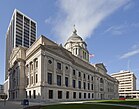Northern Indiana | |
|---|---|
 Map of counties in Indiana. Those highlighted in red are part of Northern Indiana. | |
| Country | United States |
| State | Indiana |
| Largest city | Fort Wayne |
| Population (2020) | 2,317,804 |
Northern Indiana is a geographic and cultural region that generally comprises the northern third of the U.S. state of Indiana and borders the states of Illinois to the west, Michigan to the north, and Ohio to the east. Spanning the state's northernmost 26 counties, its main population centers include Northwest Indiana (anchored by the cities of Hammond and Gary and part of the larger Chicago metropolitan area), Michiana (anchored by the cities of South Bend, Mishawaka, and Elkhart), and the Fort Wayne metropolitan area (anchored by the city of Fort Wayne).
Northern Indiana's physical geography was significantly shaped during Wisconsin glaciation, resulting in a till plain ranging from flat to gently rolling terrain, especially in the Wabash Valley. The region experiences a humid continental climate, supporting temperate deciduous forest, tallgrass prairie, and wetland ecosystems. In addition to Lake Michigan, more than 300 kettle lakes are located in the region, including the state's largest natural lake (Wawasee) and deepest natural lake (Tippecanoe). Following the Valparaiso Moraine, the Laurentian Divide meanders through the region, separating the watersheds of the Great Lakes Basin to the north from those of the Mississippi River drainage basin to the south.
Northern Indiana is situated within the larger Rust Belt and Corn Belt regions, influencing the area's geographic, economic, cultural, and political landscape. Home to about 2.3 million people, the region is defined by both its industrial cities and agricultural towns. Manufacturing remains a vital part of the region's economy, particularly in the production of recreational vehicles, medical devices, and steel. Protected areas include Indiana Dunes National Park and Indiana's most visited state park of the same name.[1] Northern Indiana is home to about 25 public and private higher education institutions, including more than a dozen religiously affiliated colleges and universities. The region is split between the Eastern and Central time zones.[2]
- ^ "2020 / 2021 Estimated Fiscal Year Visits - Indiana State Parks" (PDF). Indiana Department of Natural Resources. Retrieved January 26, 2024.
- ^ Mack, Justin L. (March 8, 2019). "Looking back at Indiana's complicated relationship with time: Why Indiana observes daylight saving time". The Indianapolis Star. Retrieved January 26, 2024.
© MMXXIII Rich X Search. We shall prevail. All rights reserved. Rich X Search






